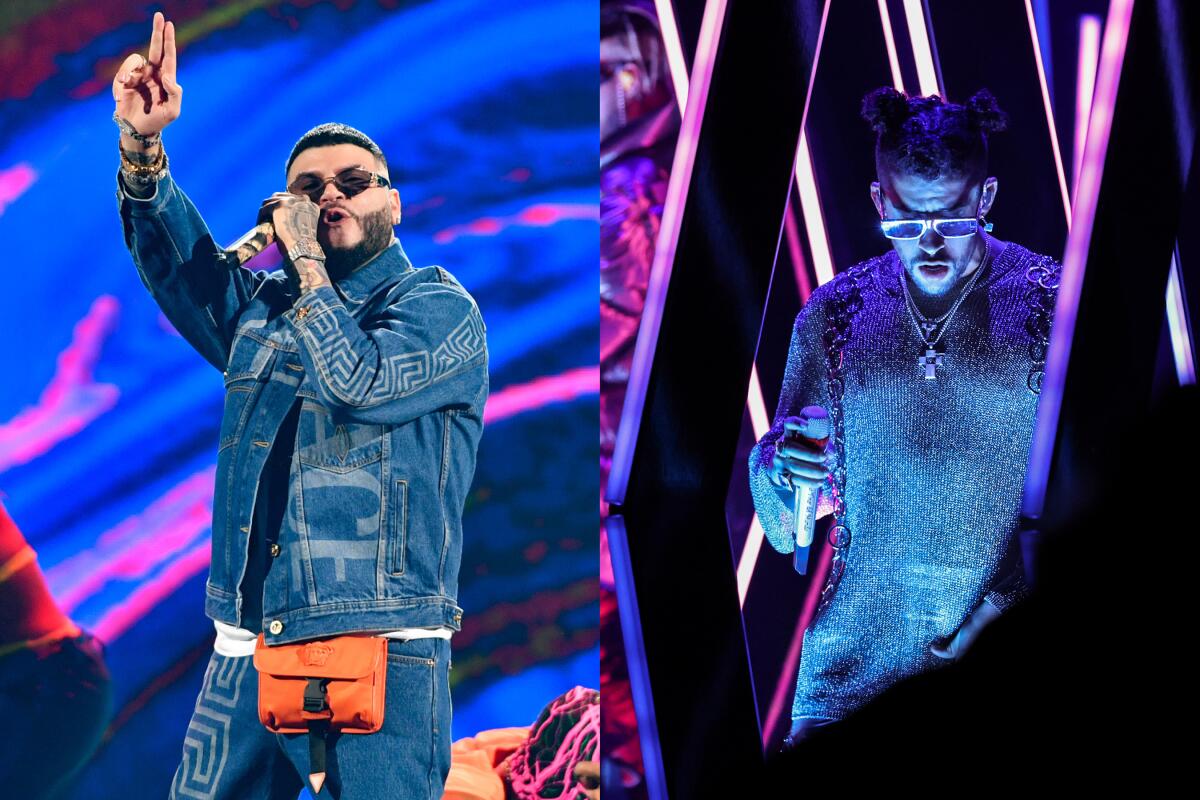Reggaeton dances to a new beat, as lilt of dembow gives way to thump of EDM

Decades before Farruko became one of Puerto Ricoâs stand-out reggaeton MCs, the 30-year-old was a huge fan of Eurodance artists like Alice Deejay.
âThat was my childhood,â confesses Farruko of the 1990s techno-pop sound that colored his latest studio album, âLa 167,â and its breakthrough hit, the high-energy Latin house jam âPepas.â
âPepasâ has topped Billboardâs Hot Latin Songs chart for seven weeks, and has remained affixed in the top 10 of the Spotify Global 50 chart. Dutch DJ TiĂŤsto dropped a remix of âPepasâ last week, and the songâs streams show no signs of slowing down.
âI may have fans that only listen to reggaeton, but Iâm a multifaceted artist. I want to evolve my music,â Farruko told The Times. ââPepasâ was an experiment, and it happened to work.â

Farruko is one of a growing number of artists who first built their audiences through reggaeton, before turning to the EDM world for inspiration. This past year has seen a sizable uptick in dance fusions climbing the Latin charts, among them Bad Bunny and Jhay Cortezâs âDĂĄkiti,â Karol Gâs country-disco track âLocationâ and Rauw Alejandroâs electro-pop hit âTodo De Ti.â
At the forefront of this emerging wave of electro-reggaeton is Colombian crossover star J Balvin. Since 2017, several of his songs have appeared on global dance/electronic charts, including collaborations with Major Lazer, David Guetta and Black Eyed Peas.
You wonât have to be vaccinated, but youâll need at least proof of a negative COVID-19 test to attend next springâs Coachella and Stagecoach festivals.
When Balvin recorded âIn Da Getto,â his joint 2021 hit with Skrillex, he told Paper Magazine, âI didnât have Latinos in mind.â
A callback to the 1994 house track, âIn de Ghetto,â producers Skrillex and Tainy outfitted Balvinâs Spanish-language vision with pumped-up, jock-jam organs and an accelerated modulation of reggaetonâs core riddim known as dembow. The song is now certified gold in Italy and platinum in Spain.

Katalina Eccleston, co-producer of Spotifyâs new podcast, âLoud: The History of Reggaeton,â suspects that the genreâs turn caters more toward marketing goals than creative ones. âThere is a bottom line, and thatâs expanding markets,â she says.
âTheyâre taking something thatâs already popularâ â EDM â âand seeing how much bigger their audience can grow.â
After once being criminalized in Puerto Rico, reggaeton finally endeared itself to the mainstream in the early 2000s. Tego CalderĂłn won over fans across Latin America with his 2002 debut âEl Abayarde,â while Daddy Yankee scored U.S. crossover appeal with 2004âs âBarrio Fino.â Don Omarâs 2006 LP, âKing of Kings,â achieved a then-unprecedented feat for a reggaeton album by ranking No. 7 on the Billboard 200.
On Friday, AppleTV+ will premiere âThe Velvet Underground,â acclaimed director Todd Haynesâ documentary on the bandâs origins, influences and music.
After this initial gold rush, many reggaeton artists went back to the drawing board, thirsty for fresh takes on their beloved homegrown sounds. This coincided with the global rise of EDM: By the late aughts, as house music and its variants permeated pop and R&B music in the United States, Mexican acts like 3Ball MTY developed the regional EDM fusion known as tribal guarachero, while genres like nu-cumbia and funk carioca rippled well beyond their origins in South America. Many of these sounds were interpolated into whatâs now referred to as âglobal bass.â
In Puerto Rico, producers like DJ Blass and Tainy sought to transform reggaeton with the same techniques that artist-producers like Timbaland and Daft Punk had used to influence American pop. This sparked what Eccleston calls the era of âperreo galactico,â a house-driven subgenre of reggaeton in which veterans like Omar and Wisin y Yandel dabbled in electronic dance on songs like âVirtual Divaâ and âSexy Movimiento.â
Commercially, such experiments fizzled out by 2011, and, in the years leading up to the 2017 sensation âDespacito,â reggaeton struggled once more to attain industry recognition.
Now, the majority of top charting Latin songs are not just by reggaeton artists â they are EDM fusions.

âIn the beginning, reggaeton was a fusion sound,â says Miami-based Luis J. Gonzalez, who produces under the moniker Mr. Nais Gai. He assisted in several tracks on âVice Versa,â the latest album by emerging Puerto Rican star Rauw Alejandro. âOver time, any artist should want to innovate their genre.
âThe bass is critical,â adds Gonzalez, who cites Deadmau5âs breakthrough electro-house album â4Ă4=12â as an influence. âReggaeton and house each have their own style, but they share the same principle. What brings them together is that boom boom that makes you move.â
Puerto Rican hitmaker Jhay Cortez shared the same ethos in writing his latest album, âTimelezz,â on which Skrillex shares credits on the Latin electronica track, âEn Mi Cuarto.â
âAnything that makes you dance can be universal,â said Cortez in a recent interview with The Times.
Does this shift to EDM mean that reggaeton may be experiencing a decline?
âLike EDM, reggaeton is global music at this point,â says Cortez. âItâs not going anywhere.â
More to Read
The biggest entertainment stories
Get our big stories about Hollywood, film, television, music, arts, culture and more right in your inbox as soon as they publish.
You may occasionally receive promotional content from the Los Angeles Times.













